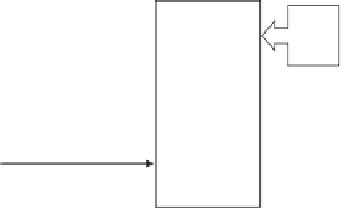Environmental Engineering Reference
In-Depth Information
Efficiency of CHP systems
In terms of energy output to total fuel consumed, the overall efficiency of a CHP system can
be calculated as follows:
Electrical energy Useful thermal energy
Fuel energy input
+
[11.5]
η
=
CHP
For separate heat and power, the thermal efficiency for the boiler (
h
Boiler
) and the efficiency
for electricity only generation (
h
Electricity
) are as follow:
Useful thermal output
Fuel energy input
[11.6]
η
=
Boiler
Energy output
Fuel energy input
[11.7]
η
=
Electricity
The overall efficiency of separate heat and power is then:
Electrical energy
+
Useful thermal energy
η
=
[11.8]
SHP
Electrical energy
η
+
Useful thermal energy
η
Electricity
Boiler
Figure 11.8 presents a comparison between a conventional separate heat and power system
with a CHP. For the purpose of illustration, assume that 30 units of electricity and 45 units
of heat are needed for a particular process and that the efficiency for the boiler is 80 percent
and for the power plant 31 percent. To produce the same amount of electricity and heat,
the conventional generation system needs 154 units of fuel to generate 75 (30 + 45) units of
energy, resulting in an overall efficiency of 49 percent (75/154), or according to Equation
11.6
h
SHP
= [30 + 45]/[30/0.31 + 45/0.8]). On the other side, the CHP system uses only
100 units of energy to produce the same output, so the overall efficiency is 75 percent
(EPA, 2008).
Conventional
generation
Combined heat
and power
Power plant
fuel (98 units)
30 units
electricity
Power plant
Combined
heat and
power
154 units fuel
100 units fuel
Boiler fuel
(56 units)
Heat
Heat
45 units
steam
Boiler
49% overall
efficiency
75% overall
efficiency
Figure 11.8
Conventional generation of electricity and heat and a combined heat and power unit (CHP).
Adapted from Environmental Protection Agency (EPA), 2008.


















